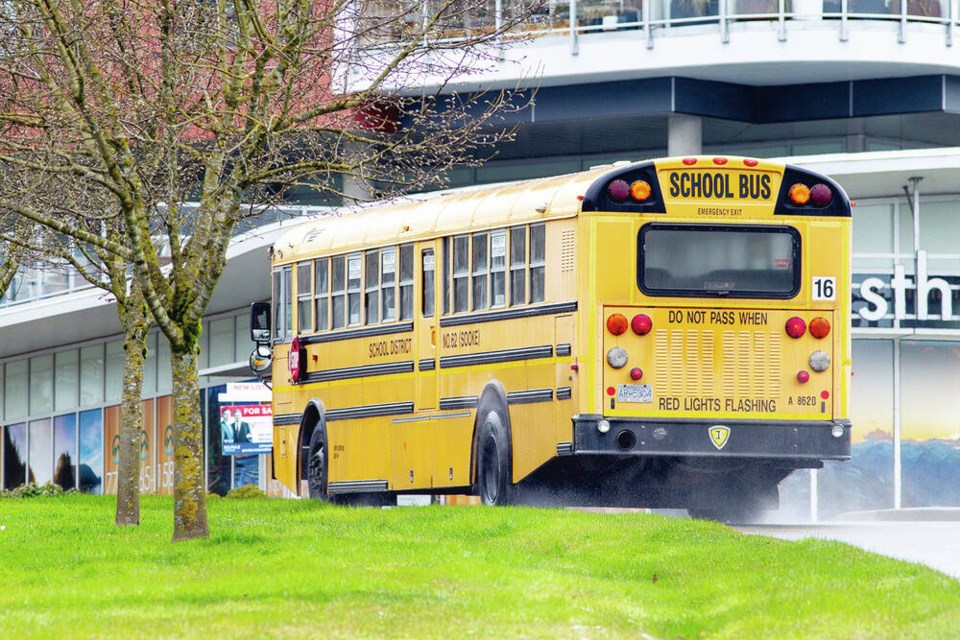More than a year after a pilot program testing the benefits of three-point seatbelts on school buses wrapped up in the Nanaimo-Ladysmith School District, a federal government task force has yet to report and act on the findings.
Transport Canada spokesperson Sau Sau Liu said the pilot projects in B.C. and Ontario concluded in June 2023 and the final report is being compiled “with the aim to help inform decision-making about whether to mandate seatbelts on school buses in Canada.”
Seatbelts became news again last month after a school bus carrying Grade 6 and 7 students from 100 Mile House-area schools home on a field trip went off Highway 97 in central B.C., just north of Lac La Hache. The bus went down a 15-metre embankment, injuring about 36 people.
A 67-year-old pedestrian was killed in a subsequent collision.
Days later, when Premier David Eby was asked why seatbelts are not required on school buses, he said it was “strange” they were not.
Eby said the province will work with Transport Canada to determine if they would have helped in the Lac La Hache crash.
“Any way that we can ensure that our kids are safer, we’re going to make sure that we take those steps when they’re going to school, especially in more rural and remote communities, on school buses,” said Eby.
The premier’s office said the ministries of Education and Transportation have contacted Transport Canada asking for an update on the task force report.
In B.C., federal-provincial pilot projects took place in Nanaimo-Ladysmith and Fraser-Cascade public school districts.
Tracy Mowat, transportation manager for Nanaimo-Ladysmith Public Schools, said the majority of its school bus drivers and transportation staff deemed the seatbelts and other safety features — extra cameras, extended stop arms and auto braking — “very positive.”
Mowat said in a statement that bus drivers found students’ seatbelt use beneficial in many ways, including helping to keep students in their seats. “In the event of a crash, both the seatbelts and … the soft high backs of school bus seats can protect students.”
Bus drivers reported, however, that monitoring and reminding students to wear their seatbelts added to their workload, as well as the time it took to load the bus.
The buses equipped with seatbelts remain in the district’s fleet and are used daily. The district continues to include seatbelts with new bus purchases, Mowat said.
B.C. Transportation Minister Rob Fleming said the province began about six years ago buying only school buses that had seatbelts or had the fixtures needed to install them. School buses are typically replaced every 12 to 15 years.
Fleming said he believes seatbelts should be mandatory on school buses, just as they are in other passenger vehicles.
“I think the evidence is there that it’s a good idea,” said Fleming.
“This tragedy [in the Cariboo] is a stark and painful reminder about why, and it’s a discussion that I’ll continue to have with my federal counterpart.”
Transport Canada, which mandates seatbelts on a variety of vehicles, says when used and installed properly, seatbelts on school buses can complement existing safety features such as energy-absorbing high back seats situated close together to provide what’s called compartmentalization.
About two million Canadian school children travel to and from school every day on about 51,000 school buses, according to Statistics Canada.
Transport Canada’s national collision database says since 2002, there have been six fatalities of school-aged children riding school buses and 3,441 injuries.
The federal agency says making sure children are properly secured in seatbelts is more challenging in a 70-passenger school bus than in a five-passenger car.
“This is one of the reasons we allow provinces, territories and school bus operators to decide whether to install seatbelts. They are ultimately responsible for school bus operations.”
In January 2019, a Task Force on School Bus Safety focused on seatbelts was established, resulting in the 2020 final report Strengthening School Bus Safety in Canada.
The report acknowledges that three-point seatbelts on school buses can protect kids “by reducing the risk of ejection and lowering the risk of serious injury, particularly in the context of collisions involving rollover, side-impact, or vertical-lift scenarios.”
The task force recommended protection features such as energy-absorbing side-structure padding and inflatable “curtain” airbags, and agreed to launch pilot projects to explore the viability of seatbelt requirements in Canada.
Lewis Smith, manager of national projects for the Canada Safety Council in Ottawa, who provided input to the task force, said school-bus seatbelt design and installation has improved.
“Now that the possibility of a combination lap and shoulder belt exists, they can absolutely be an additional layer of safety for collisions involving rollover, side-impact and vertical lift,” he said.
Smith noted, however, that most collisions are still front or rear-end crashes, where existing safety features such as high-back absorbent seats provide a high degree of safety.
In 2018, Transport Canada published a regulation for the correct installation on school buses of three-point seatbelts “should provincial and territorial governments decide to pursue this option.”
Smith said with the growing use of seatbelts and the 2018 regulations for installing them, it’s “not a leap” to suggest the government may be headed in that direction.
“This is ultimately Transport Canada’s decision,” said Smith. “We’re supportive of the research that they’re doing currently, and if that bears out that seatbelts are going to be a permanent fixture on school buses, that’s certainly a decision we would support.”
>>> To comment on this article, write a letter to the editor: [email protected]



